Research Shows Your Dog May Share Your Personality Traits
Dr. Nicholas Dodman, Center for Canine Behavior Studies
 Your dog's behavior has more to do with yours than you might think. Dogs can develop all kinds of personality issues and new research shows that their humans might have something to do with it. Dr. Nicholas Dodman says your craziness can rub off on your dog.
Your dog's behavior has more to do with yours than you might think. Dogs can develop all kinds of personality issues and new research shows that their humans might have something to do with it. Dr. Nicholas Dodman says your craziness can rub off on your dog.
One of the things that Dr. Dodman is doing since having left tufts is working with a group called the Center for Canine Behavior Studies. Visit his website where you can find more details on how your personality affects your dog's behaviors.
Dr. Dodman tells us about an inaugural study that was labor intensive and took place over two years. It involved over 1,500 people who filled out questionnaires about their own personality as well as the dog's behavior. The idea was to find out what the impact was of a person's personality on their dog.
The long and short of it, they found a person's personality had an affect on their dog's behavior by using a psychological inventory called the "10 Item Personality Inventory," otherwise known as TIPI, which measures what are called the big five personality traits. These are extroversion, agreeableness, conscientiousness, emotional stability and openness to new ideas.
People who scored low in these traits, for example if a person was not so much extroverted but more in the introverted direction, the person who was much less agreeable and less conscientious or less emotionally stable, those people tended to have more behavior issues. Or put the other way, people who were emotionally more robust, extroverted, agreeable, well met, conscientious and stable, those people had not only fewer behavior problems, they had a positive effect of suppressing those problems.
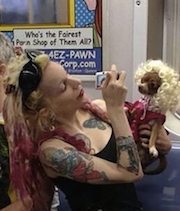 Dr. Dodman tells us there were super interesting findings and it was published in the People's Library of Science. The fact is that this is all very nice to have found this, but how could it be put to a self-practical purpose? He then became aware of the existence of a group called, "How I Met My Dog," which is a potential owner and new adoptive dog match. They match the dog's personality, which is measured through their algorithm, with a potential adopter. Now, with help from the Center for Canine Behavior Studies measuring the human's personality, this science makes it even more spectacular. Dr. Dodman is thrilled to find a practical application into something that people could actually use to find the ideal match for a dog they were potentially going to adopt.
Dr. Dodman tells us there were super interesting findings and it was published in the People's Library of Science. The fact is that this is all very nice to have found this, but how could it be put to a self-practical purpose? He then became aware of the existence of a group called, "How I Met My Dog," which is a potential owner and new adoptive dog match. They match the dog's personality, which is measured through their algorithm, with a potential adopter. Now, with help from the Center for Canine Behavior Studies measuring the human's personality, this science makes it even more spectacular. Dr. Dodman is thrilled to find a practical application into something that people could actually use to find the ideal match for a dog they were potentially going to adopt.
But what if you have a person that's an introvert, nervous and not agreeable, would you want to put them with a dog? Wouldn't that just bring out bad behavior in that dog? Dr. Dodman says no. He states it could well be that through the match that you might find a dog who was themselves more introverted and quiet and you could actually find a combination that would work.
Wouldn't it make more sense to do the opposite and match up somebody who's an introvert and who's a couch potato that needs to get some exercise with a dog that would get them out to meet people? This scenario will also work, because it's not necessarily so that you have to match an introvert with an introvert. In fact, there are many more factors come in the match.
Some factors to consider are that there are people who unfortunately tend to buy dogs just basically by their appearance and beauty as they say, is only fur deep. People just don't consider the full impact of what they're doing at the beginning, which leads to surrendering the dog.
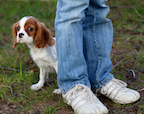 So the algorithm or questionnaire that matches them is designed to do things for situations where you might see a cute St. Bernard pup. However, you're not the kind of person who is equipped to deal with a dog that's going to grow up to be the size of a small horse in your small house, or a dog that needs a lot of grooming, or a dog that's a super high energy dog, who might be better matched with a person who is fond of hiking and enjoys sporting activities. You can then find a dog that is a perfect match for you and your lifestyle.
So the algorithm or questionnaire that matches them is designed to do things for situations where you might see a cute St. Bernard pup. However, you're not the kind of person who is equipped to deal with a dog that's going to grow up to be the size of a small horse in your small house, or a dog that needs a lot of grooming, or a dog that's a super high energy dog, who might be better matched with a person who is fond of hiking and enjoys sporting activities. You can then find a dog that is a perfect match for you and your lifestyle.
There's more than just the findings at the Center for Canine Behavior Studies. It's a complicated process of finding what will work for an individual. It may be that a person admits that they're looking for quiet company or an introvert who really would like to be a little bit more outgoing. They can use these findings in the How I Met My Dog algorithm along with the Center for Canine Behavior Studies findings to find the perfect match, as there's really a dog for every purpose under heaven and a dog for every owner.
Visit Website
Finding Pet Friendly Vacation Spots
Ashley Mengwasser, Pets Welcome Here TV
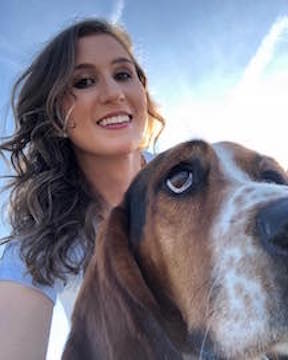 Television host Ashley Mengwasser is traveling the country looking for the best places to take your pets. She'll show you not the spots that just tolerate pets, but the locations that roll out the red carpet for Fido. Check out her program called Pets Welcome Here TV.
Television host Ashley Mengwasser is traveling the country looking for the best places to take your pets. She'll show you not the spots that just tolerate pets, but the locations that roll out the red carpet for Fido. Check out her program called Pets Welcome Here TV.
Pets Welcome Here TV is a half hour television special that will be broadcasting across the country July through September. Ashley will be going to destinations that are pet friendly. She's not talking about pet tolerant places, she's talking about the places that roll out the red carpet for you and your pet to vacation there. These places don't just accept pets, but they actually want you to bring your pets. They wan to cater to your pet! No more feeling like you have to leave your pet behind when vacation time rolls around.
Some of the places Ashley will be visiting will be restaurants, where not only are your pets allowed, they have all natural treats and freshwater or dog bowls for animals. Other places are hotels that furnish pet beds and homemade treats that they make in the hotel for your pet when you travel.
But Ashley won't be traveling to these places alone, she will be bringing her four-legged furry better half, Rosie. Rosie is a five and a half year old Basset Hound who will be joining her on several of the destinations. Ashley tells us it was a special adventure for the both of them.
 Pets Welcome Here TV is the brainchild of their brilliant show creator, Heather Eisenstadt, who just kind of became a resource for her friends and family who were constantly asking her, "Where can I take my pet?" Because people who love their pets don't want to leave them when they go on vacation!
Pets Welcome Here TV is the brainchild of their brilliant show creator, Heather Eisenstadt, who just kind of became a resource for her friends and family who were constantly asking her, "Where can I take my pet?" Because people who love their pets don't want to leave them when they go on vacation!
One of the sponsors of Pets Welcome Here TV is Top Dog Pet Travel. They are a full service travel agency for pet friendly vacations. Another sponsor is Charlie Bear, who creates these amazing grain-free pocket treats. They are great training treats or just reward treats that are less than three calories per treat.
Pets Welcome Here TV will premier in cities across the country this July. To learn when and where the show will be on in your area, please visit PetsWelcomeHere.TV, where you will find the air date and time for the network affiliate that might be broadcasting in your city, with new updates over the next coming weeks. Check it out and you'll get to see a lot of cool tricks that they have planned up their furry sleeves on this show.
Visit Website
Woman Earns $50K Making Chicken Clothing
Julie Baker, Pamper Your Chicken
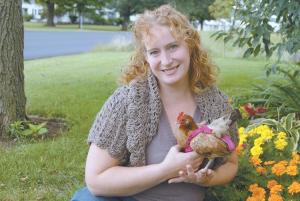 Julie Baker accidentally started a chicken clothing company by making fashionable-looking diapers for pet chickens - but now her company, Pampered Poultry, has gone on to add tutus, sweaters and dresses. She earns about $50,000 yearly.
Julie Baker accidentally started a chicken clothing company by making fashionable-looking diapers for pet chickens - but now her company, Pampered Poultry, has gone on to add tutus, sweaters and dresses. She earns about $50,000 yearly.
Julie never thought that creating chicken clothing, particular chicken diapers, would be a big business for her. Surprisingly, she explains that it all started out very innocently and has since been a series of just the universe saying it's the thing for her to do.
Originally, Julie started making chicken clothing to protect her own furniture. Next she started making the clothing for family and friends who actually showed chickens in competitions. Then before she knew it, she was staying up late sewing chicken diapers and knew she needed a different solution.
It all started about eight or ten years ago when Julie's daughter was homeschooled at the time. She tells us they didn't have chickens in the house, but her daughter would just bring them in. Julie then needed something to protect the furniture. In order to keep the chickens from defecating on the furniture, she created diapers. This is how the whole thing started.
Julie's daughter showed poultry for several years, which includes a lot of cleaning and grooming that goes into the birds before you bring them to a show. So after you do all that work, it's kind of nice to keep them in that clean state. Originally, the primary market for the diapers was for people who were showing chickens at competitions and not as much for pet chickens. However, over the last five or six years she's experienced an explosion of people who started out as small backyard chicken people and now these chickens have sort of wiggled their way into the homes over the years. People really are keeping them as sort of pets first and egg producers second.
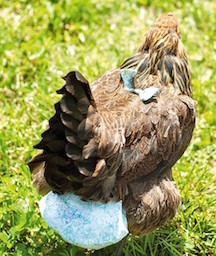 So how do you put a diaper on a chicken so they can't take it off? Julie explains that it took a lot of trial and error to get a design that both would stay on the chicken and be comfortable enough for it to be able to fly up to its perch and be able to walk around and kind of do it's chicken thing without being too impeded by the diaper.
So how do you put a diaper on a chicken so they can't take it off? Julie explains that it took a lot of trial and error to get a design that both would stay on the chicken and be comfortable enough for it to be able to fly up to its perch and be able to walk around and kind of do it's chicken thing without being too impeded by the diaper.
The chicken diapers are designed with a pouch that holds the poop and an apron that goes under its belly. Then there are elastic straps that go over the wings and attach with a bow so they can't really wiggle it off. She also uses lightweight cotton so that it doesn't add a lot of extra weight to the chicken. The pouch is made of a waterproof nylon and big enough to allow you to put a paper towel in there to make it easy to change and clean out. But if it does leak through the paper towel, it doesn't leak through to the cotton and leak onto your floor, your furniture or your lap.
When she first started the company, Julie wanted to do fashionable attire. She felt if you're going to be goofy enough to put a diaper on a chicken, they might as well look good while you're doing. Julie uses different types kinds of fabrics and has anywhere from six to twelve patterns at any point in time, which rotate monthly. Some are fun and whimsical, like butterflies, ladybugs or bumblebees and sometimes they're a little bit more high fashion. Some of Julie's wholesale accounts even prefer the bright Chevrons and geometric patterns. As a result, she makes them in a whole wide range of styles.
Besides the chicken clothing, Julie has a DIY chicken sweater kit. She believes the theory behind sweaters is that there's been a real surge in popularity with some of the real specialty breed birds and they're not as cold hardy as we might like them. So when the temperatures dip, particularly in warmer climates where there have been a lot of cold snaps, some of the Silkie chickens, the Naked Neck Chickens and the Showgirl Chickens don't necessarily have the same feather protection that the standard layers do, so sweaters help them whether some of the weather.
Julie tells us there was always a sort of a crossover between useful and sort of whimsical and fun with her clothing. Last year she introduced the tutus, which she is hard pressed to come up with a useful purpose for that other than it makes for an absolutely fabulous Instagram shoot. This has been part of the popularity of a lot of the chicken dresses selling over the last few years. The sales of dresses and tutus have just skyrocketed. Julie feels that now that people are treating their chickens much more as pets, just like people dress their dogs up, people also love to dress their chickens up. The chickens are super cute when they are wearing clothing. They run around and they do all kinds of cute things. You can post a picture of them on your Facebook page or Instagram feed. You can even tweet out your bird riding on a John Deere tractor with your son mowing the lawn, while they are wearing a tutu.
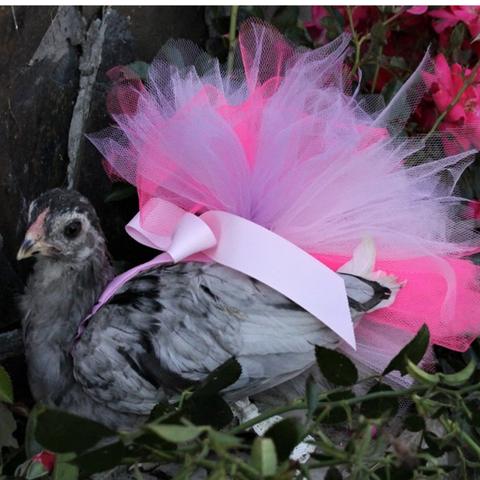 In fact, Julie says her customers send her pictures all the time of the crazy situations they've put their birds in. She's even received pictures of tea parties where the little girl is all dressed up and sitting on the back of the chair is a chicken in a tutu. She's also had people send portrait type of pictures where they've had matching outfits for their kids and they've included their favorite bird. She believes that more and more people are realizing that chickens have amazing personalities; not every chicken, but there are chickens that you just fall in love with.
In fact, Julie says her customers send her pictures all the time of the crazy situations they've put their birds in. She's even received pictures of tea parties where the little girl is all dressed up and sitting on the back of the chair is a chicken in a tutu. She's also had people send portrait type of pictures where they've had matching outfits for their kids and they've included their favorite bird. She believes that more and more people are realizing that chickens have amazing personalities; not every chicken, but there are chickens that you just fall in love with.
So what can you expect when you're diapering a chicken? Will the chicken allow you to do this easily? No, Julie says its not super easy, as it's never a chicken's first choice to wear a diaper. She thinks that most of them are like, "Oh my goodness, you're kidding me!" It does take some birds longer than others to get used to wearing them. She has a video on her website that's kind of hilarious where the chickens are kind of stumbling around and some will even just lay down and won't get up. Some will even kind of twirl around in circles as they're trying to get their balance. But after about 10 to 20 minutes, especially if you sort of distract them with their favorite treats, they get used to the weight change. It's primarily a balance issue for them because the diapers, even though she tries to make them as light as possible, still add additional weight. Then the elastic is sort of pulling over the front of their chest. So it's a sensation that they're not used to. It's a weight that they're not used to. It just takes them a little bit of time to get used to it. But once they're used to it, they act like they don't even have it on.
Visit Website
Don't Litter - Spay or Neuter Instead! - Dr. Debbie
 Do you believe your beautiful pedigreed pooch just has to be bred, or that your cat can't possible get outside to become pregnant, or that you long to have just one litter from Fluffy? Listen up, shelter staff, veterinarians and animal advocates all join together to encourage spaying and neutering. It's the right thing to do for your pet's health, and is a step forward in addressing pet overpopulation issues. With approximately 4 million dogs and cats euthanized at U.S. shelters every year, pet owners can do their part to avoid unintended and unnecessary breeding.
Do you believe your beautiful pedigreed pooch just has to be bred, or that your cat can't possible get outside to become pregnant, or that you long to have just one litter from Fluffy? Listen up, shelter staff, veterinarians and animal advocates all join together to encourage spaying and neutering. It's the right thing to do for your pet's health, and is a step forward in addressing pet overpopulation issues. With approximately 4 million dogs and cats euthanized at U.S. shelters every year, pet owners can do their part to avoid unintended and unnecessary breeding.
Your individual decisions on altering your pet do matter. Animals, left to do what they will, result in a lot of generations of whiskers and tails in just a short period of time. A pair of dogs can produce 67,000 puppies in 3 years' time. And cats in that same time frame can prosper to over 420,000 kittens.
Common Spay & Neuter Fallacies:
Isn't it better to let my female dog go into heat before I spay her?
FALSE. You can minimize the risk of breast cancer to zero by spaying before the first heat. Allow her to have a few heat cycles, and your dog has a 25-percent chance of developing breast cancer. The health benefits for females also include preventing uterine cancer and the life-threatening reproductive infection, pyometra.
Isn't it better to let a female dog have at least one litter of pups?
FALSE. There is no psychological or health benefit in allowing a female dog to have a litter. It does not make her a better, more affectionate pet. On the contrary, some pregnant female dogs are quite protective and aggressive to anyone disturbing her brood.
My dog is a purebred dog with a pedigree so it is meant to be bred
FALSE. Having purebred papers doesn't mean an animal has to be bred. There is no shortage of purebred animals, with purebred dogs accounting for 30-percent of all animals currently in shelters.
 It's a great experience to allow children witness the beauty of birth by letting your pet have a litter
It's a great experience to allow children witness the beauty of birth by letting your pet have a litter
STOP. What really is beautiful is to impart children with a sense of value toward animal life. Yes, birth is a miracle to behold. But there are many books and videos that demonstrate birth in a responsible manner, without unnecessary pet breeding.
Teach your children to care for your existing pets, from puppyhood or kitten hood until senior pet years. Children learn responsibility while caring for a pet and develop an appreciation for the human-animal bond by living it daily.
Won't spaying or neutering my pet make my pet fat?
FALSE. You directly control what, when and how much your pet eats. The fate of your pet's waistline lies in your hands. Your pet's metabolism may slow down some after spaying or neutering, but with sensible feeding and regular exercise you can maintain a healthy weight for your pet.
It's expensive to spay or neuter my pet
FALSE. There are many affordable solutions to ensuring your pet is spayed or neutered. Some veterinary hospitals and shelters offer special programs on Spay Day. And other facilities offer year round low-cost options.
Still not convinced spaying & neutering is worth it? Consider that the cost of spay or neuter is less than the cost of raising kittens or pups for a year. And don't ignore the possible realities of pregnancy problems. An emergency C-section for a pet having labor difficulties costs $1000 or more.
I want my dog to guard the house. Won't spaying or neutering make my pet less protective?
FALSE. There is no relation between your pet having reproductive organs and performing as a guard dog. A dog's protective behavior is based on instinct and training. Surgically spaying or neutering doesn't change your pet's devotion to protect home and family members. And once a dog is spayed or neutered, it has less desire to roam away from home to find a mate.
Take action now
Of course you want to do what's best for your pet. Life is busy with family demands, work and a stream of errands. But don't delay this important step to keep your pet healthy for a lifetime together with you.
Featured veterinarian known as "Dr. Debbie" on national pet radio program, Animal Radio. Ebook author of "Yorkshire Terriers: How to Be Your Dog's Best Friend"; "Pugs: How to Be Your Dog's Best Friend"; "Mini Schnauzers: How to Be Your Dog's Best Friend"; and "Shih Tzu: How to Be Your Dog's Best Friend." Dr. Debbie's books.
Visit Website
Animal Radio News - Lori Brooks
 Delta Bans "Pit Bull-Type Dogs"
Delta Bans "Pit Bull-Type Dogs"
Delta has added its name to the growing list of airlines that have unveiled new, stricter policies about animals on airplanes. Delta says its new rules are driven by safety considerations and intended to ensure that service or emotional support animals are traveling only with passengers who truly have disabilities. The airline also announced it would prohibit all "pit bull-type dogs" as service or support animals due to safety concerns following recent incidents in which several employees were bitten. The announcement was met with immediate backlash, especially from some service dog organizations and disability advocates who said they believe the Delta ban is not legal under federal laws. Furthermore, the Department of Transportation also cast doubt on the legality of the policy saying, "A limitation based exclusively on breed of the service animal is not allowed under the Department's Air Carrier Access Act regulation." Whether an airline breed ban would hold up in court has never been tested, but cases involving other federal disability laws have and they have sided with owners of the dogs. The Justice Department enforces the Americans with Disabilities Act, which has said breed-specific bans do not apply to service animals of those breeds. However, airlines are subject to the Air Carrier Access Act and when it comes down to previous court cases, the Americans with Disabilities Act has triumphed over other regulations.
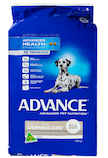 Mars Petcare Food Linked to Incurable Disease
Mars Petcare Food Linked to Incurable Disease
The Australian division of the global pet food company Mars Petcare has been dealing with a sad and difficult to understand mess involving one of its foods, Advance DermoCare, which has been implicated in more than 100 Australian dogs being diagnosed with megaesophagus. As a result of all the negative attention, Mars is now the first major pet food company to support Australian pet food regulation after years of the industry down under insisting there was no need for formal oversight. In Australia, the $4 billion pet food industry is currently self-regulated though pressure has been mounting on its Federal Government to take action. In the US, the FDA regulates the pet food industry. Megaesophagus, sometimes referred to as Mega E, is an incurable and debilitating condition where dogs struggle to swallow food and water. In fact, Melbourne University researchers are still investigating whether there's evidence to definitively link the more than 100 megaesophagus cases to Advance Dermocare. Owners of dogs with megaesophagus have criticized Mars for recalling the product three months after it first learned of a potential problem.
Pet Geese Prevail Over City Hall
A Connecticut town has changed one of its local ordinances after a woman fought to keep her pet geese. The city will now allow the birds to stay in her backyard and she gets to keep her flock. The woman won her case by showing vet records proving they're her pets, but roosters or other species of birds are still not allowed.
Company Offers "Paternity" Leave
A Norwegian pet supply company has a new policy that is getting a lot of attention. It is giving its employees paid time off to bond with their new pets. Musti Group, the largest pet supply company in the Nordic countries, which has more than 1,500 employees, recently began offering "pawternity leave" that consists of three paid days off when they acquire a new puppy or kitten.
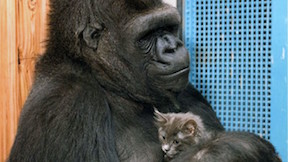 Koko Passes
Koko Passes
Koko, the sweet and thoughtful gorilla who captured the world's attention through her ability to use sign language, recently passed away in her sleep at her home at the Gorilla Foundation's preserve in California. Koko was born at the San Francisco Zoo and spent her entire life in captivity. She was believed to have had an IQ of between 75 and 95. The average IQ of a human is around 90 to 110. Koko could sign more than 1,000 words and understood spoken English. She was on the cover of National Geographic twice, the last time in 1985, which had an image of her mourning the death of one of her pet kittens.
Who Is Your Favorite On-Screen Pet?
According to the results of a new survey, the title of America's Most Favorite Ever On-Screen Pet goes to Scooby Doo. Followed by the rest of the top ten: 2. Snoopy; 3. Lassie; 4. Toto; and 5. Garfield. The remaining five are between Beethoven; Tom of Tom and Jerry; Old Yeller; Lady from "Lady and the Tramp;" and Marley from the movie "Marley and Me."
 Listen to the entire Podcast of this show (#970)
Listen to the entire Podcast of this show (#970)





